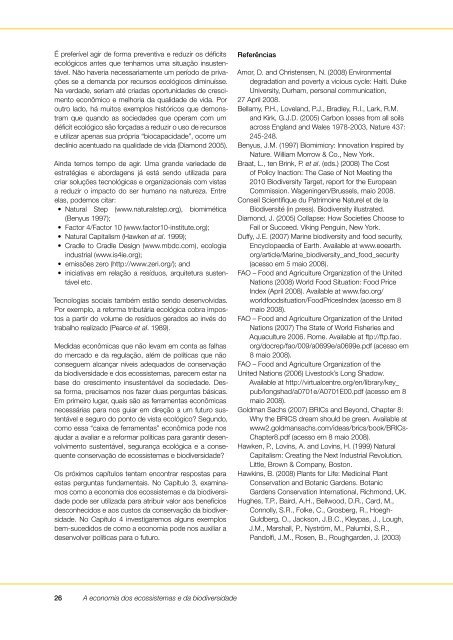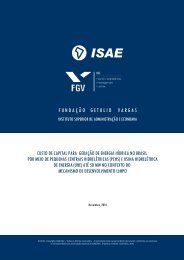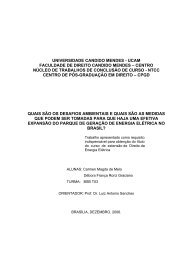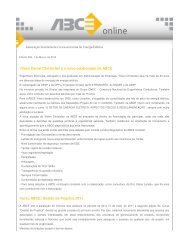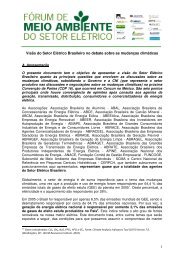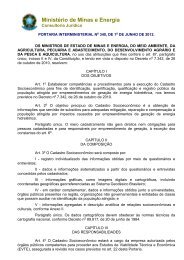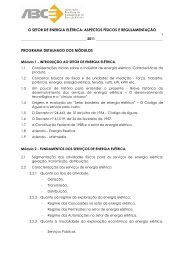A economia dos ecossistemas e da biodiversidade - TEEB
A economia dos ecossistemas e da biodiversidade - TEEB
A economia dos ecossistemas e da biodiversidade - TEEB
You also want an ePaper? Increase the reach of your titles
YUMPU automatically turns print PDFs into web optimized ePapers that Google loves.
É preferível agir de forma preventiva e reduzir os déficits<br />
ecológicos antes que tenhamos uma situação insustentável.<br />
Não haveria necessariamente um período de privações<br />
se a deman<strong>da</strong> por recursos ecológicos diminuísse.<br />
Na ver<strong>da</strong>de, seriam até cria<strong>da</strong>s oportuni<strong>da</strong>des de crescimento<br />
econômico e melhoria <strong>da</strong> quali<strong>da</strong>de de vi<strong>da</strong>. Por<br />
outro lado, há muitos exemplos históricos que demonstram<br />
que quando as socie<strong>da</strong>des que operam com um<br />
déficit ecológico são força<strong>da</strong>s a reduzir o uso de recursos<br />
e utilizar apenas sua própria “biocapaci<strong>da</strong>de”, ocorre um<br />
declínio acentuado na quali<strong>da</strong>de de vi<strong>da</strong> (Diamond 2005).<br />
Ain<strong>da</strong> temos tempo de agir. Uma grande varie<strong>da</strong>de de<br />
estratégias e abor<strong>da</strong>gens já está sendo utiliza<strong>da</strong> para<br />
criar soluções tecnológicas e organizacionais com vistas<br />
a reduzir o impacto do ser humano na natureza. Entre<br />
elas, podemos citar:<br />
• Natural Step (www.naturalstep.org), biomimética<br />
(Benyus 1997);<br />
• Factor 4/Factor 10 (www.factor10-institute.org);<br />
• Natural Capitalism (Hawken et al. 1999);<br />
• Cradle to Cradle Design (www.mbdc.com), ecologia<br />
industrial (www.is4ie.org);<br />
• emissões zero (http://www.zeri.org/); and<br />
• iniciativas em relação a resíduos, arquitetura sustentável<br />
etc.<br />
Tecnologias sociais também estão sendo desenvolvi<strong>da</strong>s.<br />
Por exemplo, a reforma tributária ecológica cobra impostos<br />
a partir do volume de resíduos gera<strong>dos</strong> ao invés do<br />
trabalho realizado (Pearce et al. 1989).<br />
Medi<strong>da</strong>s econômicas que não levam em conta as falhas<br />
do mercado e <strong>da</strong> regulação, além de políticas que não<br />
conseguem alcançar níveis adequa<strong>dos</strong> de conservação<br />
<strong>da</strong> biodiversi<strong>da</strong>de e <strong>dos</strong> <strong>ecossistemas</strong>, parecem estar na<br />
base do crescimento insustentável <strong>da</strong> socie<strong>da</strong>de. Dessa<br />
forma, precisamos nos fazer duas perguntas básicas.<br />
Em primeiro lugar, quais são as ferramentas econômicas<br />
necessárias para nos guiar em direção a um futuro sustentável<br />
e seguro do ponto de vista ecológico? Segundo,<br />
como essa “caixa de ferramentas” econômica pode nos<br />
aju<strong>da</strong>r a avaliar e a reformar políticas para garantir desenvolvimento<br />
sustentável, segurança ecológica e a consequente<br />
conservação de <strong>ecossistemas</strong> e biodiversi<strong>da</strong>de?<br />
Os próximos capítulos tentam encontrar respostas para<br />
estas perguntas fun<strong>da</strong>mentais. No Capítulo 3, examinamos<br />
como a <strong>economia</strong> <strong>dos</strong> <strong>ecossistemas</strong> e <strong>da</strong> biodiversi<strong>da</strong>de<br />
pode ser utiliza<strong>da</strong> para atribuir valor aos benefícios<br />
desconheci<strong>dos</strong> e aos custos <strong>da</strong> conservação <strong>da</strong> biodiversi<strong>da</strong>de.<br />
No Capítulo 4 investigaremos alguns exemplos<br />
bem-sucedi<strong>dos</strong> de como a <strong>economia</strong> pode nos auxiliar a<br />
desenvolver políticas para o futuro.<br />
Referências<br />
Amor, D. and Christensen, N. (2008) Environmental<br />
degra<strong>da</strong>tion and poverty a vicious cycle: Haiti. Duke<br />
University, Durham, personal communication,<br />
27 April 2008.<br />
Bellamy, P.H., Loveland, P.J., Bradley, R.I., Lark, R.M.<br />
and Kirk, G.J.D. (2005) Carbon losses from all soils<br />
across England and Wales 1978-2003, Nature 437:<br />
245-248.<br />
Benyus, J.M. (1997) Biomimicry: Innovation Inspired by<br />
Nature. William Morrow & Co., New York.<br />
Braat, L., ten Brink, P. et al. (eds.) (2008) The Cost<br />
of Policy Inaction: The Case of Not Meeting the<br />
2010 Biodiversity Target, report for the European<br />
Commission. Wageningen/Brussels, maio 2008.<br />
Conseil Scientifique du Patrimoine Naturel et de la<br />
Biodiversité (in press). Biodiversity illustrated.<br />
Diamond, J. (2005) Collapse: How Societies Choose to<br />
Fail or Succeed. Viking Penguin, New York.<br />
Duffy, J.E. (2007) Marine biodiversity and food security,<br />
Encyclopaedia of Earth. Available at www.eoearth.<br />
org/article/Marine_biodiversity_and_food_security<br />
(acesso em 5 maio 2008).<br />
FAO – Food and Agriculture Organization of the United<br />
Nations (2008) World Food Situation: Food Price<br />
Index (April 2008). Available at www.fao.org/<br />
worldfoodsituation/FoodPricesIndex (acesso em 8<br />
maio 2008).<br />
FAO – Food and Agriculture Organization of the United<br />
Nations (2007) The State of World Fisheries and<br />
Aquaculture 2006. Rome. Available at ftp://ftp.fao.<br />
org/docrep/fao/009/a0699e/a0699e.pdf (acesso em<br />
8 maio 2008).<br />
FAO – Food and Agriculture Organization of the<br />
United Nations (2006) Livestock’s Long Shadow.<br />
Available at http://virtualcentre.org/en/library/key_<br />
pub/longshad/a0701e/A0701E00.pdf (acesso em 8<br />
maio 2008).<br />
Goldman Sachs (2007) BRICs and Beyond, Chapter 8:<br />
Why the BRICS dream should be green. Available at<br />
www2.goldmansachs.com/ideas/brics/book/BRICs-<br />
Chapter8.pdf (acesso em 8 maio 2008).<br />
Hawken, P., Lovins, A. and Lovins, H. (1999) Natural<br />
Capitalism: Creating the Next Industrial Revolution.<br />
Little, Brown & Company, Boston.<br />
Hawkins, B. (2008) Plants for Life: Medicinal Plant<br />
Conservation and Botanic Gardens. Botanic<br />
Gardens Conservation International, Richmond, UK.<br />
Hughes, T.P., Baird, A.H., Bellwood, D.R., Card, M.,<br />
Connolly, S.R., Folke, C., Grosberg, R., Hoegh-<br />
Guldberg, O., Jackson, J.B.C., Kleypas, J., Lough,<br />
J.M., Marshall, P., Nyström, M., Palumbi, S.R.,<br />
Pandolfi, J.M., Rosen, B., Roughgarden, J. (2003)<br />
26 A <strong>economia</strong> <strong>dos</strong> <strong>ecossistemas</strong> e <strong>da</strong> biodiversi<strong>da</strong>de


